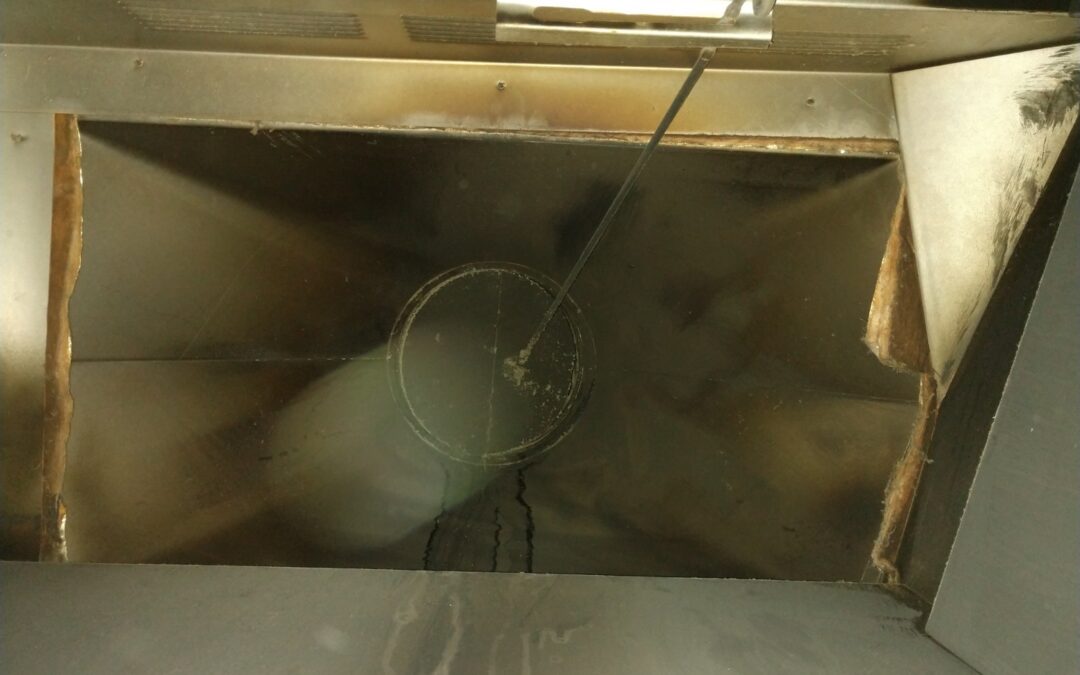
by blogediter | Jun 1, 2023 | Fireplaces
How to use a chimney plug in my chimney, if my fireplace flue has 4 slanted walls? Does a Chimney Balloon really work in this fireplace, or should I make a DIY chimney plug?
Q: I am trying to use a chimney plug to seal an 11 inch diameter circle damper situation with the rod handle, as you can see in the picture. My goal is to primarily seal the flue from insects and pests and second reason is energy efficiency.
Would you please let me know how to use a chimney plug in my chimney, and which chimney plug and size is best for my damper handle situation. Thanks! – Ibrahim
A: Hi Ibrahim, I would recommend you use the 12″ round Flueblocker above the flue damper. That will work better than a Chimney Balloon in this fireplace. In order to install it, you will tuck the wool pad past the open damper without the handle attached. Then spear the Flueblocker handle into the wool pad clamp and tighten the handle by turning it to thread it into the hole on the clamp. One it is threaded you can use the leverage of the Flueblocker handle to push the wool pad into place above the chimney damper. It will look like the photo below. It will do a great job stopping bugs and drafts. – Jason R
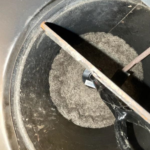
Flueblocker installed above the damper
Contact us if you are wondering how to use a inflatable chimney plug or wool fireplace plug as a chimney draught stopper in my chimney?
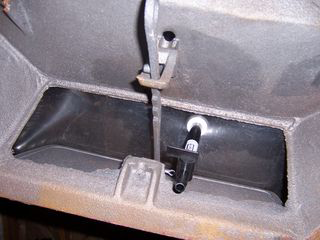
by blogediter | May 24, 2019 | Fireplaces
Q: Do I close the chimney damper after installing the Chimney Balloon?- JJ
A: Dear JJ, There is no need to close the damper below your Chimney Balloon. The Chimney Balloon is doing the job of the damper and quite frankly it is doing a better job than the metal damper could anyway. So closing the damper after the Chimney balloon is installed is like closing a screen door on the inside of a submarine.
However, You can have the damper closed if you have the Chimney Balloon in there far enough to close it. There are a few things to keep in mind though if you do decide to close the damper. If you try to force the damper closed it may put upward pressure on the valve section of your Chimney Balloon. That is a little tough on your Chimney Balloon since it puts undue pressure on the valve and Chimney Balloon.
The other issue is if you close your damper you may forget you installed the Chimney Balloon and just open the damper and start a fire.
Personally, I leave my damper open and leave the inflation tube attached, so it dangles just above my head when I open the glass doors to the fireplace. With this solution, I still have no draft problem and I haven’t accidentally melted a Chimney Balloon yet. – Jason
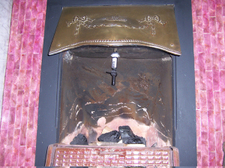
by blogediter | Apr 8, 2019 | Chimney Plugs
Q: Jason – I have a decision to make. I can either pay a chimney sweep $950 to replace my metal flue damper or I can just have him clean the chimney and buy a Chimney Balloon. Which one should I do? – TR
A: TR – Well to be honest with you $950 sounds like a rather large amount to replace a metal damper, I hope he including a chimney cleaning with that quote. I am of course assuming that your fireplace is of a standard make & size. If your chimney required a custom fabricated damper it would be much more expensive and would have been obvious from the quote.
The answer to this question lies almost entirely in two questions …How often do you use your fireplace? And how concerned are you with conserving your homes heat?
If you use your fireplace less than once a week on average you would certainly be better off just going for a chimney cleaning and a Chimney Balloon. In this case you are an occasional user of your fireplace and it spends much more time out of use than in use. You want as tight of a seal on your fireplace flue as possible to maximize heat savings and minimize chimney creosote smell.
If you use your fireplace more often than once a week on average you probably are not that concerned about loosing heat from your home since fireplaces tend to waste much more heat than they create for your home. The US Department of Energy states that regular use of an open fireplace will actually increase your heating bill. The major point of the Chimney Balloon is that is saves heat, not that it is easier to use than a damper.
So in this case you want to consider replacing the metal damper. You will get an inferior seal on you flue with a metal damper, but it will more convenient for you to use than a Chimney Balloon. As it is, most homeowners forget to close their damper after having a fire, and you may grow weary of installing and uninstalling your Chimney Balloon and some day you will just stop using it.
TR, I could give you a pat answer that “Of course the Chimney Balloon is your best option!!” but I think you will appreciate seeing it from both sides. – Jason
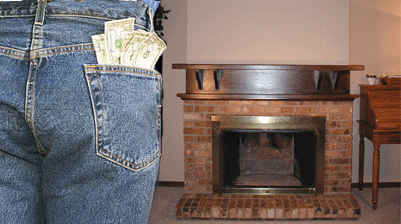
by blogediter | Feb 25, 2019 | Fireplaces
Fire Place sucksanim
On a cold winter eve who of us is not tempted to go to the living room and stoke up a fire in the fireplace and read a book in front of the fire? You may be thinking “I am doing myself a favor by supplementing the furnace with additional heat”, but in fact, you are making your house colder and could be contributing significantly to pollution depending upon how you burn.
The wood burning fireplace is a losing proposition
The air action that a wood burning fireplace initiates in our home is wasteful. The moment the damper is opened heated air begins pouring out of the top of the chimney. As the fire in the hearth accelerates, the combustion process grabs already heated air from your home and burns the oxygen and combustible gasses in it. The heat that is created in this combustion quickly rises and grabs more heated inside air and tosses it up the chimney. You can restrict the amount of inside air that the fireplace has access to by installing glass doors, but this will also severely limit the amount of radiant heat that fireplace can cast forward into your living space. This radiant heat is the heat you feel on your skin in front of the fireplace and is the only usable heat that the fireplace will produce since the combustion heat is pouring out the top of the chimney. In the meantime, the home is drawing in cold outside air from other places (i.e. windows, light sockets, doors, etc) to replace the air that is escaping the home through the chimney. This is referred to as the “stack effect”.
Loosing heat even while dormant
Even while the wood fireplace is not being used, the traditional metal dampers tend to leak air since they warp and degrade rapidly in the extreme heat and corrosive soot environment. The removable and reusable Chimney Balloon fireplace chimney damper available in assorted sizes inflates into place in the flue and seals it off efficiently to stop heat loss and the cold draft.
The good, the bad, and the pollution
If you burn a fast hot fire this creates very little smoke and pollution, and it can give you a noticeable amount of radiant heat gain in the room the fireplace it is in. However, it is using volume amounts of your already heated inside air for its combustion which exceeds your heat gain ratio. A slower fire is even worse since you are still loosing heated air out the chimney and getting very little radiant heat in return. This black type of fireplace smoke is a terrible pollutant and contributes to respiratory irritant for people with asthma and allergies.
Wood burning fireplaces are wonderful nostalgic centerpieces for many American homes. But a homeowner should be aware of the issues associated with fireplace use.
Sources:
US Department of Energy
WoodHeat.org
GreenBuildingElements.com
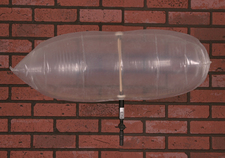
by blogediter | Dec 17, 2018 | Chimney Plugs
Chimney Balloon large
Q: Jason, I have a masonary fireplace that appears to have no chimney damper. I have measured the rectangular area after the firebox and it’s approximately 25.5″ X 9.5″. What size Chimney Balloon would be best suited. thanks. – RG
A: RG, For an area that is 25.5″ x 9.5″ I would recommend the 30×9 Chimney Balloon. Chimney Balloons are slightly oversized by their inflatable nature, and a half inch will not make a difference when you install it. – Jason





